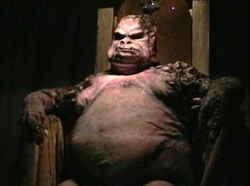
 As a teenager, while most of my peers thought that George Lucas or Steven Spielberg were the end-all, be-all of filmmaking, I instead spent most of my free time repeatedly renting and always watching the shot-on-video flicks of Todd Sheets, Tim Ritter and, my personal favorite, Ohio’s J.R. Bookwalter.
As a teenager, while most of my peers thought that George Lucas or Steven Spielberg were the end-all, be-all of filmmaking, I instead spent most of my free time repeatedly renting and always watching the shot-on-video flicks of Todd Sheets, Tim Ritter and, my personal favorite, Ohio’s J.R. Bookwalter.
Perhaps best known for the zombie epic The Dead Next Door, it was the 1995 movie Ozone where I believe he came into his own, crafting a hallucinogenic tale of clean cops and dirty mutants in their own war for the titular designer drug Ozone and its nightmarish effects.
During an ambush with some drugged-out creeps, plainclothes policeman Eddie (former Cleveland Brown James Black) is injected with the mysterious narcotic. As he tries to track down the manufacturer, he begins to experience horrific drifts in and out of reality, including that of an underground fight club filled with Ozone-addicted monsters.
 Designed by a grotesque blob in a basement with vague worldwide ambitions, the real reason why the drug has become so popular with maniacally obsessive users is more nefarious than expected, edging into dark religious territories I wasn’t anticipating.
Designed by a grotesque blob in a basement with vague worldwide ambitions, the real reason why the drug has become so popular with maniacally obsessive users is more nefarious than expected, edging into dark religious territories I wasn’t anticipating.
While many of these backyard horror movies sitting on rental shelves were often more laughable than anything else, Bookwalter always seemed to strive for a look and feel that suited the very low budget instead of hindering it, oftentimes coming up with audacious films that played better than they really had any right to; Ozone exemplifies that.
In addition to Bookwalter’s direction, much of the film sets on Black’s broad football-player shoulders, forging an unheralded action hero plagued by demons, both literal and figurative. And while the film just exudes a ’90s sense of camcorder-based nostalgia, I realized it’s something that is sorely missed in these heady days of high-definition flicks shot and edited on a computer. —Louis Fowler
